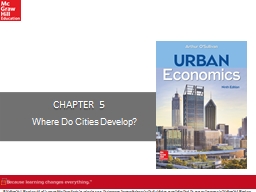

TransportIntensive Firms A transportintensive firm is defined as a firm for which transport costs are responsible for a relatively large fraction of total cost For a transportintensive firm the dominant location factor is the cost of transporting inputs and outputs ID: 1027567
Download Presentation The PPT/PDF document "CHAPTER 5 Where Do Cities Develop?" is the property of its rightful owner. Permission is granted to download and print the materials on this web site for personal, non-commercial use only, and to display it on your personal computer provided you do not modify the materials and that you retain all copyright notices contained in the materials. By downloading content from our website, you accept the terms of this agreement.
1. CHAPTER 5Where Do Cities Develop?
2. Transport-Intensive FirmsA transport-intensive firm is defined as a firm for which transport costs are responsible for a relatively large fraction of total cost. For a transport-intensive firm, the dominant location factor is the cost of transporting inputs and outputs. The firm’s objective is to choose the location that minimizes total transport costs and output transport cost.
3. Transport-Intensive Firms: AssumptionsThe classic model of a transport-intensive firm has four assumptions that make transportation cost the dominant location factor:Single transportable outputSingle transportable inputFixed-factor proportionsFixed pricesUsing these assumptions, discuss how a firm maximizes its profit by minimizing its transportation costs.
4. Resource-Oriented Firms: Monetary Weights for a Resource-Oriented FirmA resource-oriented firm is a firm that has a relatively high cost of transporting its input.Using the example of a firm that produces baseball bats, discuss the functioning of a resource-oriented firm.
5. Resource-Oriented Firms: A Resource-Oriented Firm at the Input Source
6. Market-Oriented Firms: Monetary Weights for a Market-Oriented FirmA market-oriented firm is a firm that has relatively high costs for transporting its output to the market.Using the example of a bottling firm, discuss the functioning of a market-oriented firm.
7. Market-Oriented Firms: A Market-Oriented Firm at the Market
8. The Principle of Median LocationAccording to the principle of median location, firms that have multiple inputs or markets will have a median location that minimizes total travel distance.The principle of median location can be used to predict where a firm will locate in complex cases involving multiple inputs or markets.The median location splits the number of destinations into two equal halves, with half of the destinations in one direction and half in the other direction.
9. The Principle of Median Location: Intercity Location ChoiceFixit repairs machinery in factories that are located in five cities strung along a highway.Under the following assumptions, Fixit’s objective is to minimize the total travel distance.All inputs (tools and parts) are ubiquitous (available at all locations for the same price), so the cost of transporting inputs is zero.The price of repair service is fixed, and Fixit visits each factory once per week.Each repair trip to a factory requires a separate trip.
10. The Principle of Median Location: Intercity Location Choice (cont.)Using the example of Fixit’s objective to minimize total travel distance, discuss the principle of median location.
11. Median Location and Large Cities: Why Do Big Cities Get Bigger?
12. Transshipment Points and Port Cities:Port Location—Transshipment PointA transshipment point is defined as a place where a good is transferred from one transport mode to another. Using the example of the furniture factory, discuss why some industrial firms locate at transshipment points.
13. Labor, Energy, and Agglomeration EconomiesIn many historically resource-oriented or market-oriented industries, firms now locate far from their input sources and markets. These changes in locational orientation resulted from innovations in transportation and production that decreased transport costs. Transportation technologyProduction technology
14. Labor CostOn average, labor is responsible for about three-fourths of the cost of production.Labor is a local input in the sense that it is impractical for workers to commute outside of metropolitan areas.The long-term trend of declining transportation costs has contributed to the shift in location patterns to areas with relatively low labor costs.Discuss howwages affect local decisions at the metropolitan levelweather affects location patterns through its influence on wages
15. Energy TechnologyIn the first half of the 19th century, energy was a local input, defined as an input that cannot be transported.The refinement of the steam engine in the second half of the 19th century made energy a transportable input.The development of electricity changed the location patterns of factories.For some production facilities, the availability of cheap energy is still an important location factor.
16. Agglomeration EconomiesFirms cluster to exploit agglomeration economies.Although locating in a cluster may generate higher wages and other costs, the benefits from agglomeration more than offsets the higher costs.Agglomeration economies increase firm births and total employment.
17. U.S. Manufacturing Belt: Growth and DeclineThe U.S. manufacturing belt developed in the second half of the 19th century. It had a natural advantage in its access to relatively immobile resources, so manufacturing was concentrated there.As late as 1947, the manufacturing belt contained 70 percent of the nation’s manufacturing employment. By the year 2000, the manufacturing belt contained only about 40 percent of the nation’s manufacturing employment.Discuss the decline of the manufacturing belt in the United States.